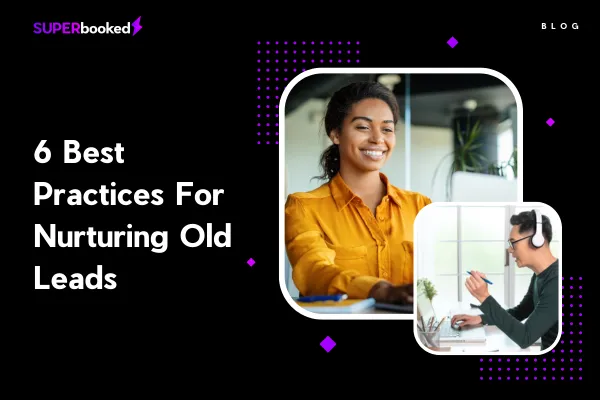Tips for success
Blog

6 Best Practices For Nurturing Old Leads
Sometimes, appointment-based businesses invest significant resources in lead generation, only to see many potential clients fall by the wayside. But what if you could revive those old, seemingly forgotten leads? That's where lead nurturing comes into play. With a fresh approach and the right marketing strategy, you can turn the tables on these once-dormant prospects and ultimately convert them into paying customers. This blog will discuss six best practices for nurturing your old leads and outline how to get them eager about doing business with you again.
Understand the reasons behind lost leads
Before delving into the lead nurturing process, it's essential to understand why these leads went cold in the first place. Understanding why these leads disengaged can provide valuable insights that can be used to enhance your future lead-generation campaigns. This analysis involves looking back at past interactions and identifying patterns and trends that may have influenced their decision to disengage.
Some reasons why a lead may have gone cold include a lack of interest in the services offered, a need for more time to consider the options, concerns not adequately addressed, or a competitor offering a better deal. By identifying the reasons for disengagement, you can tailor your lead nurturing approach to reconnect with the leads and increase your chances of success.
Segment your old leads
Knowing that not all leads are created equal is vital when reengaging old leads. To effectively reconnect with them, you should consider segmenting your leads into distinct categories based on various factors, including their original source, past interactions, the duration of inactivity, and other relevant factors. This segmentation allows you to tailor your communications to address each group's specific needs and preferences, increasing the chances of successfully reengaging them.
For example, one group of leads may have attended an event you hosted but did not book an appointment or make a purchase. Another group may have reached out for information through your website but never followed up. You can send targeted messages that resonate with each group's past experiences and interests by segmenting these leads into different categories. This personalized approach can be more effective than a generic message that may appeal to something other than the specific needs of each group.
Segmentation can also help you identify which leads are most likely to convert, allowing you to concentrate your resources on those more likely to respond positively to your lead nurturing efforts. By analyzing each segment's behavior and preferences, you can gain invaluable insights into the factors that motivate your leads, enabling you to create more effective lead-nurturing strategies.
Personalize your communication
Personalization is critical when reconnecting to old leads. Sending generic or spammy messages can quickly turn them off and make them less likely to consider doing business with your company again. Instead, it's important to make each message feel custom and thoughtful, addressing leads by their first name and referencing past interactions or interests. This approach can help build trust and establish a connection with the lead, increasing their chances of being receptive to your message.
Personalization can take many shapes, depending on the business and the lead's past interactions. For example, a personalized message might reference a conversation at an event or touch on a particular pain point that the lead expressed during a previous interaction.
You can craft customized messages tailored to the individual lead's behavior and preferences using data and analytics. This might involve highlighting products or services relevant to the lead's interests or making personalization recommendations based on past purchases.
In addition to helping to revive an old lead's interest, personalization can also help to establish a positive brand image and build customer loyalty. When recipients feel recognized and valued, they are more likely to view your company positively and share their experiences with others. This, in turn, can help to drive new business and generate referrals.
Offer something valuable
To sway old leads back into your sales funnel, present them with a compelling reason to reengage with your business. This means offering something of value that speaks to their interests and needs. For example, you could provide exclusive promotions, access to valuable content, or expert advice to help them achieve their goals.
One effective way to incentivize old leads is to offer a limited-time special or discount only available to those who book an appointment within a specific timeframe. This creates a sense of urgency and motivates them to take action. Ensuring that the value being offered aligns with their needs and demonstrates your commitment to their satisfaction is essential. This will help to create trust and boost the chances of winning back their business.
Another approach is to provide value through your content marketing efforts. Creating informative blog posts, videos, or webinars that address your leads' topics of interest can help establish your credibility and keep your business in mind. By sharing your expertise and providing valuable insights, you can demonstrate your dedication to their success and position yourself as a trusted resource.
Establish a lead nurturing workflow
Once you have laid the groundwork for your lead nurturing strategy, it's essential to establish a clear plan of action for reaching out to these old leads consistently over time. Developing a workflow specifying your communication frequency, content, and channels is crucial to ensure you stay top-of-mind without overwhelming them.
An effective lead nurturing workflow involves regular touchpoints diversified across different communication channels. This includes emails, SMS, phone calls, and social media, ensuring that you are covering all bases and catering to their preferred methods of communication. For example, some people prefer to receive updates via email, while others may be more responsive to SMS.
When developing your nurturing workflow, it's crucial to take into account the kind of content you intend to share with your leads. The content should be relevant and valuable, providing insights to help them address their pain points or achieve their goals. It's also important to vary the type of content you share, including a mix of promotional and educational content and other information your leads may find interesting.
Finally, it's essential to set a schedule for your lead nurturing campaign that is realistic and manageable. This will help ensure consistency in your outreach efforts and maintain momentum over time.
Measure your success
As you execute your lead nurturing campaign, tracking and analyzing its performance is essential to understand its impact. Continuous monitoring of key metrics such as open rates, click-throughs, conversions, and sales will help you identify areas of strength and areas for improvement.
By tracking these metrics, you can gain valuable insights into the effectiveness of your communication strategies and the content you are sharing with your leads. For instance, if you're experiencing low open rates, you might consider modifying your subject lines or optimizing the content of your emails. Similarly, if you notice low conversion rates, it may be necessary to reassess your approach to providing value or addressing the needs of your leads.
Analyzing these metrics over time can also help you recognize trends and patterns that inform future campaigns. For instance, you may notice that certain types of content or communication channels are more effective than others for particular segments of your audience. Armed with this knowledge, you can adjust your approach and better tailor your campaigns to maximize results.
Analyzing and tracking the performance of your lead nurturing campaign is essential for enhancing your return on investment (ROI) and optimizing your efforts. By regularly reviewing your metrics and making data-driven adjustments, you can increase the effectiveness of your campaigns and drive more leads down your sales funnel
Final thoughts
Reviving old leads might be more challenging than generating new ones, but it can be an invaluable way to bring in additional revenue for your appointment-based business. By understanding the reasons behind lost leads, segmenting them into distinct categories, personalizing your communication, offering value, and establishing a comprehensive nurturing workflow, you can successfully regain their interest and convert them into loyal customers. After all, the best lead nurturing practices benefit your business and prospects equally by fostering a relationship built on trust, value, and mutual benefit.
